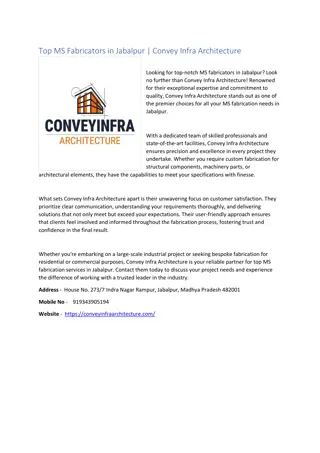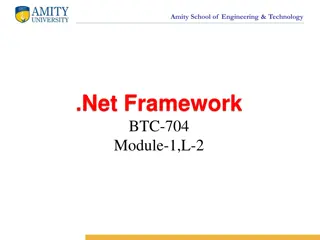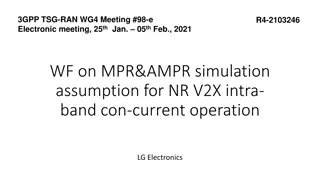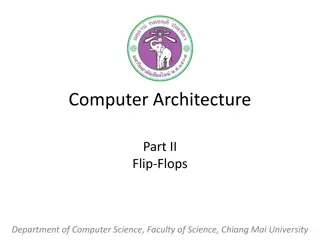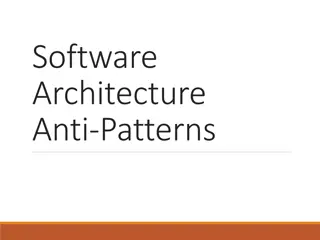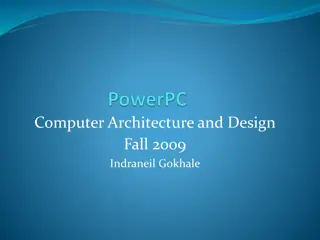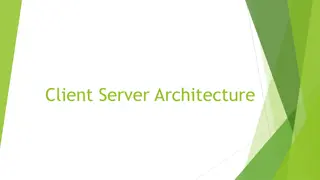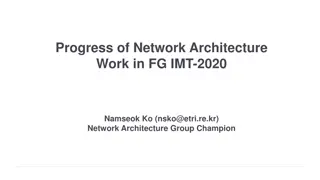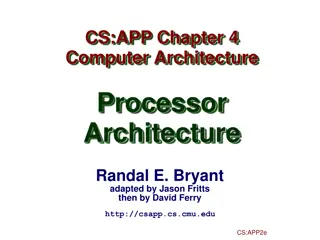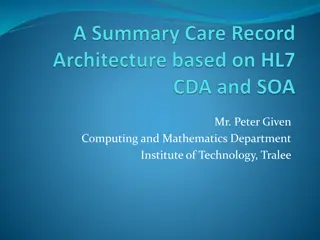Network Fundamentals: Layered Architecture and Functionality
Explore the concepts of network architecture, layering, and network functionality in this insightful lecture. Discover how different components like Ethernet, Wi-Fi, and applications like Email and Bittorrent work together to form complex networks. Delve into issues such as the nightmare scenario of managing multiple applications and media types, the importance of using indirection for effective network solutions, and the benefits of a layered network stack approach.
Download Presentation

Please find below an Image/Link to download the presentation.
The content on the website is provided AS IS for your information and personal use only. It may not be sold, licensed, or shared on other websites without obtaining consent from the author.If you encounter any issues during the download, it is possible that the publisher has removed the file from their server.
You are allowed to download the files provided on this website for personal or commercial use, subject to the condition that they are used lawfully. All files are the property of their respective owners.
The content on the website is provided AS IS for your information and personal use only. It may not be sold, licensed, or shared on other websites without obtaining consent from the author.
E N D
Presentation Transcript
CS 4700 / CS 5700 Network Fundamentals Lecture 3: Internet Architecture (Layer cake and an hourglass) Revised 1/7/13
Organizing Network Functionality 2 Networks are built from many components Networking technologies Ethernet, Wifi, Bluetooth, Fiber Optic, Cable Modem, DSL Network styles Circuit switch, packet switch Wired, Wireless, Optical, Satellite Applications Email, Web, FTP, Bittorrent, Diablo III How do we make all this stuff work together?!
Problem Scenario 3 Web Email Bittorrent VoIP This is a nightmare scenario Huge amounts of work to add new apps or media Limits growth and adoption Ethernet 802.11 Bluetooth Cellular
More Problems 4 Bittorrent Bittorrent Application endpoints may not be on the same media 802.11 Ethernet
Solution: Use Indirection 5 Web Email Bittorrent VoIP API O(1) work to add new apps, media Magical Network Abstraction Layer Few limits on new technology API API API Ethernet 802.11 Bluetooth Cellular
Layered Network Stack 6 Modularity Does not specify an implementation Instead, tells us how to organize functionality Encapsulation Interfaces define cross-layer interaction Layers only rely on those below them Flexibility Reuse of code across the network Module implementations may change Unfortunately, there are tradeoffs Interfaces hide information As we will see, may hurt performance Applications Layer N Layer 2 Layer 1 Physical Media
Key Questions 7 How do we divide functionality into layers? Routing Congestion control Error checking Security Fairness And many more How do we distribute functionality across devices? Example: who is responsible for security? Switch Switch Router
Outline 8 Layering The OSI Model Distribution The End-to-End Argument
The ISO OSI Model 9 OSI: Open Systems Interconnect Model Host 1 Switch Host 2 Application Presentation Session Transport Network Data Link Physical Application Presentation Session Transport Network Data Link Physical Layers communicate All devices implement the first three layers peer-to-peer Layers communicate peer-to-peer Network Data Link Physical
Layer Features 10 Application Presentation Session Transport Network Data Link Physical Service What does this layer do? Interface How do you access this layer? Protocol How is this layer implemented?
Physical Layer 11 Service Application Presentation Session Transport Network Data Link Physical Move information between two systems connected by a physical link Interface Specifies how to send one bit Protocol Encoding scheme for one bit Voltage levels Timing of signals Examples: coaxial cable, fiber optics, radio frequency transmitters
Data Link Layer 12 Service Data framing: boundaries between packets Media access control (MAC) Per-hop reliability and flow-control Interface Send one packet between two hosts connected to the same media Protocol Physical addressing (e.g. MAC address) Examples: Ethernet, Wifi, DOCSIS Application Presentation Session Transport Network Data Link Physical
Network Layer 13 Service Deliver packets across the network Handle fragmentation/reassembly Packet scheduling Buffer management Interface Send one packet to a specific destination Protocol Define globally unique addresses Maintain routing tables Example: Internet Protocol (IP), IPv6 Application Presentation Session Transport Network Data Link Physical
Transport Layer 14 Service Multiplexing/demultiplexing Congestion control Reliable, in-order delivery Interface Send message to a destination Protocol Port numbers Reliability/error correction Flow-control information Examples: UDP, TCP Application Presentation Session Transport Network Data Link Physical
Session Layer 15 Service Access management Synchronization Application Presentation Session Transport Network Data Link Physical Interface It depends Protocol Token management Insert checkpoints Examples: none
Presentation Layer 16 Service Convert data between different representations E.g. big endian to little endian E.g. Ascii to Unicode Interface It depends Protocol Define data formats Apply transformation rules Examples: none Application Presentation Session Transport Network Data Link Physical
Application Layer 17 Application Presentation Session Transport Network Data Link Physical Service Whatever you want :) Interface Whatever you want :D Protocol Whatever you want ;) Examples: turn on your smartphone and look at the list of apps
Encapsulation 18 How does data move through the layers? Application Presentation Session Transport Network Data Link Physical Data Data
Real Life Analogy Doesn t know how the Postal network works 19 Label contains routing info Un-packing Doesn t know contents of letter Postal Service
Network Stack in Practice 20 Host 1 Host 2 Switch Application Presentation Session Transport Network Data Link Physical Application Presentation Session Transport Network Data Link Physical Video Server FTP Server TCP IP Ethernet 802.11n Video Client UDP TCP IP Ethernet 802.11n FTP Client UDP Network Data Link Physical IP Ethernet 802.11n
Encapsulation, Revisited 21 HTTP Header Web Page Web Server TCP Header HTTP Header Web Page TCP TCP Segment TCP Header HTTP Header Web Page IP IP Header IP Datagram TCP Header HTTP Header Web Page IP Ethernet Header Ethernet Trailer Ethernet Header Ethernet Frame
The Hourglass 22 HTTP, FTP, RTP, IMAP, Jabber, One Internet layer means all networks interoperate All applications function on all networks Room for development above and below IP But, changing IP is insanely hard TCP, UDP, ICMP Think about the difficulty of deploying IPv6 IPv4 Ethernet, 802.11x, DOCSIS, Fiber, Coax, Twisted Pair, Radio,
Orthogonal Planes 23 Data Plane Application Presentation Session Transport IP Data Link Physical Well cover this later Control Plane BGP RIP OSPF
Reality Check 24 The layered abstraction is very nice Does it hold in reality? No. Firewalls Transparent Proxies NATs Analyze application layer headers Simulate application endpoints within the network Break end-to-end network reachability
Outline 25 Layering The OSI Model Distribution The End-to-End Argument
Where to Place Functionality 26 How do we distribute functionality across devices? Example: who is responsible for security? ? ? ? ? ? Switch Switch Router The End-to-End Arguments in System Design Saltzer, Reed, and Clark The Sacred Text of the Internet Endlessly debated by researchers and engineers
Basic Observation 27 Some applications have end-to-end requirements Security, reliability, etc. Implementing this stuff inside the network is hard Every step along the way must be fail-proof End hosts Can t depend on the network Can satisfy these requirements without network level support
Example: Reliable File Transfer 28 Integrity Check Integrity Check Integrity Check App has to do a check anyway! Solution 1: Make the network reliable Solution 2: App level, end-to-end check, retry on failure
Example: Reliable File Transfer 29 Please Retry In-network implementation Doesn t reduce host complexity Does increase network complexity Increased overhead for apps that don t need functionality But, in-network performance may be better Full functionality can be built at App level Solution 1: Make the network reliable Solution 2: App level, end-to-end check, retry on failure
Conservative Interpretation 30 Don t implement a function at the lower levels of the system unless it can be completely implemented at this level (Peterson and Davie) Basically, unless you can completely remove the burden from end hosts, don t bother
Radical Interpretation 31 Don t implement anything in the network that can be implemented correctly by the hosts Make network layer absolutely minimal Ignore performance issues
Moderate Interpretation 32 Think twice before implementing functionality in the network If hosts can implement functionality correctly, implement it a lower layer only as a performance enhancement But do so only if it does not impose burden on applications that do not require that functionality
Reality Check, Again 33 Layering and E2E principals regularly violated Firewalls Transparent Proxies NATs Conflicting interests Architectural purity Commercial necessity
Takeaways 34 Layering is a nice way to organize network functions Unified Internet layer decouples apps, enables innovation E2E argument (attempts) to keep IP layer simple Think carefully when adding functionality into the network
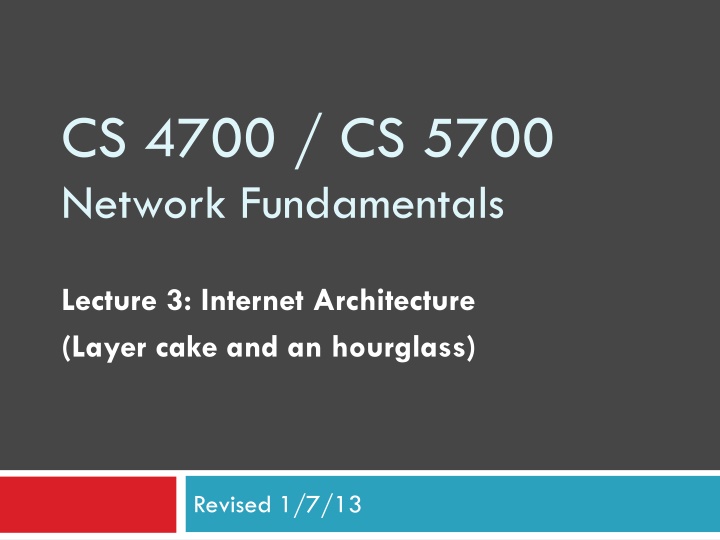

![❤Book⚡[PDF]✔ The Apollo Guidance Computer: Architecture and Operation (Springer](/thumb/21611/book-pdf-the-apollo-guidance-computer-architecture-and-operation-springer.jpg)




